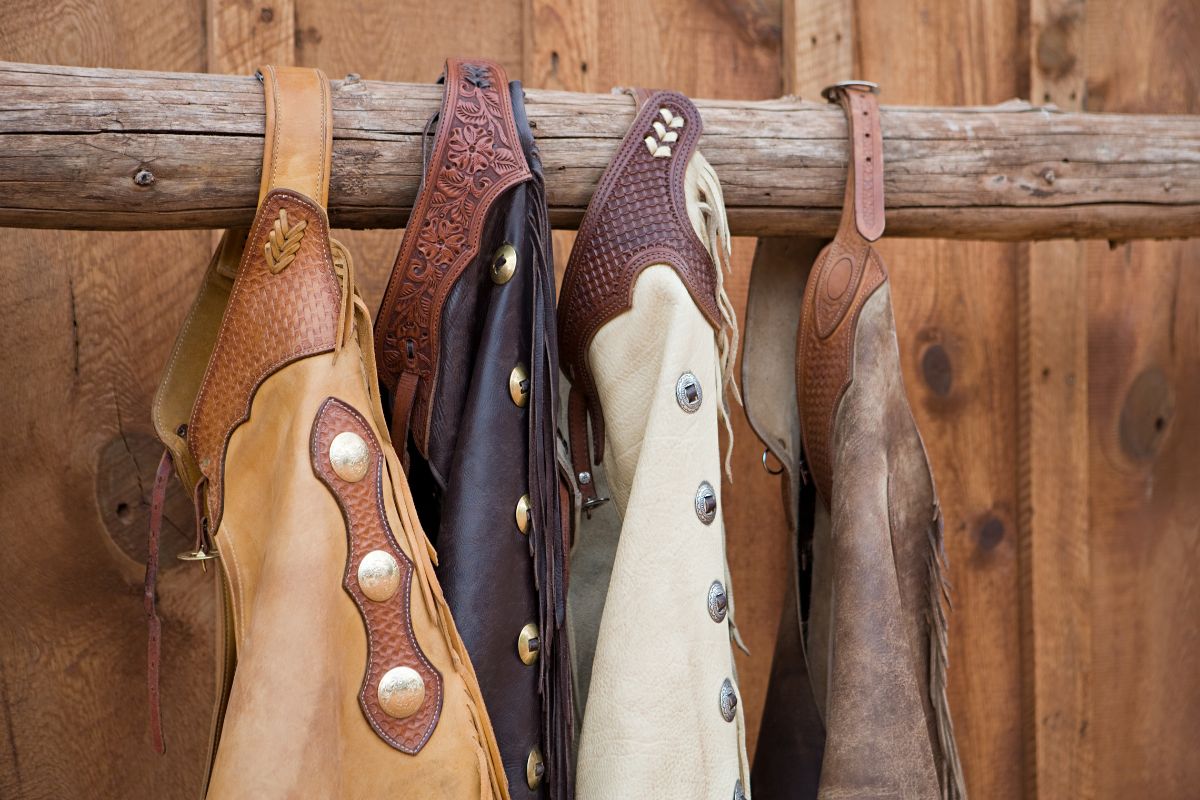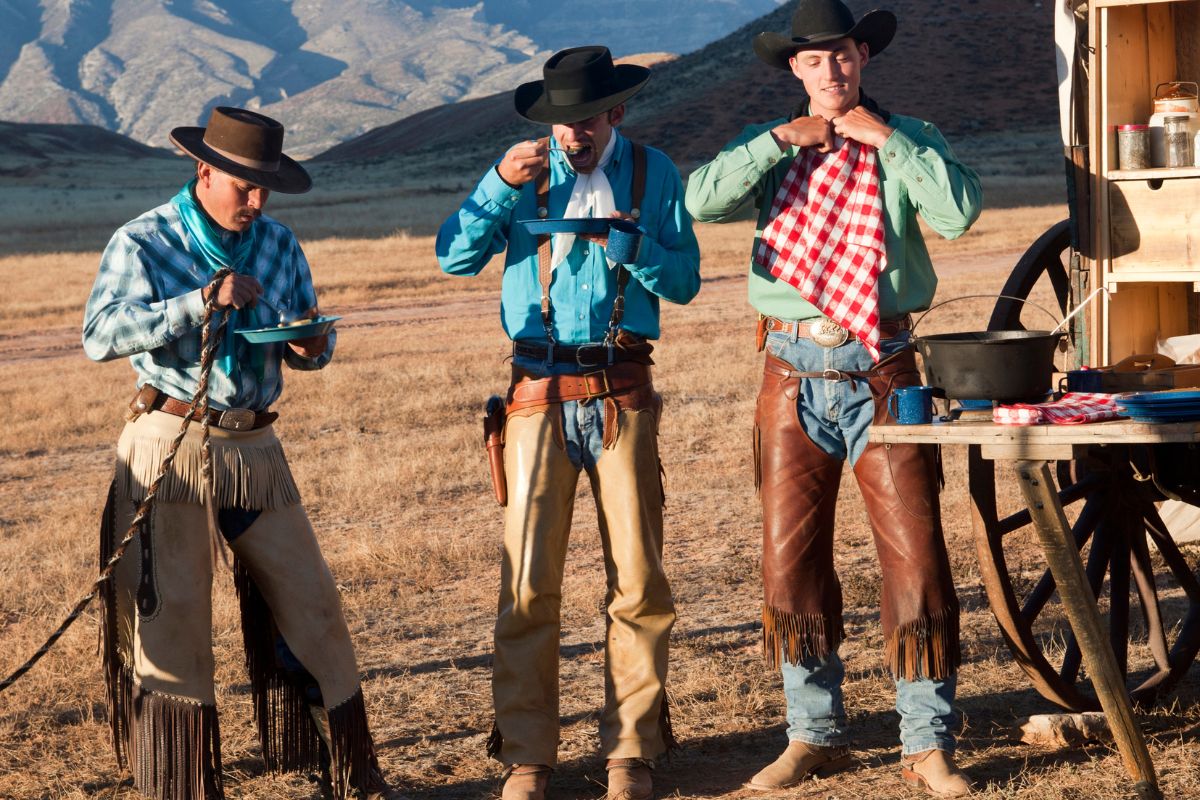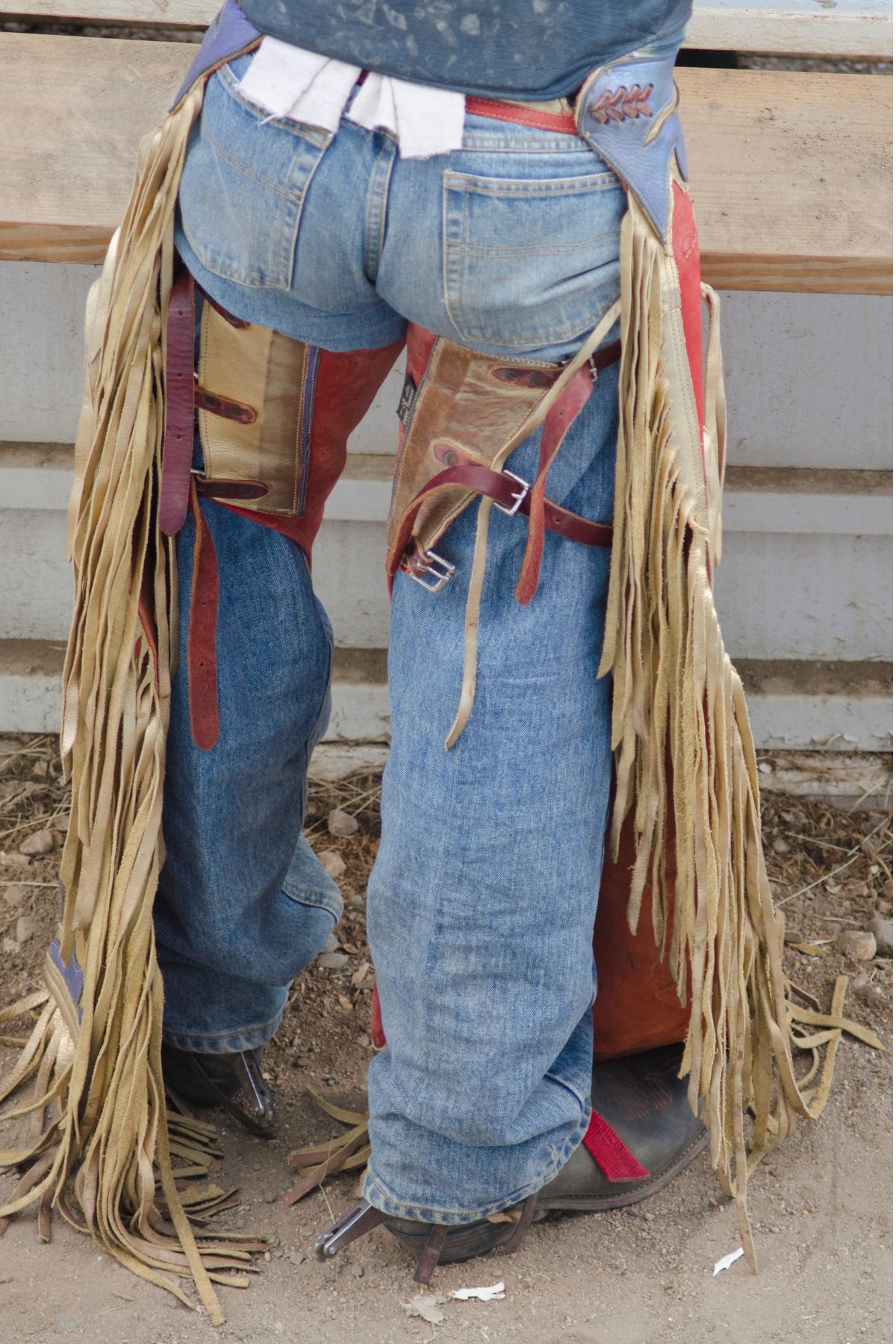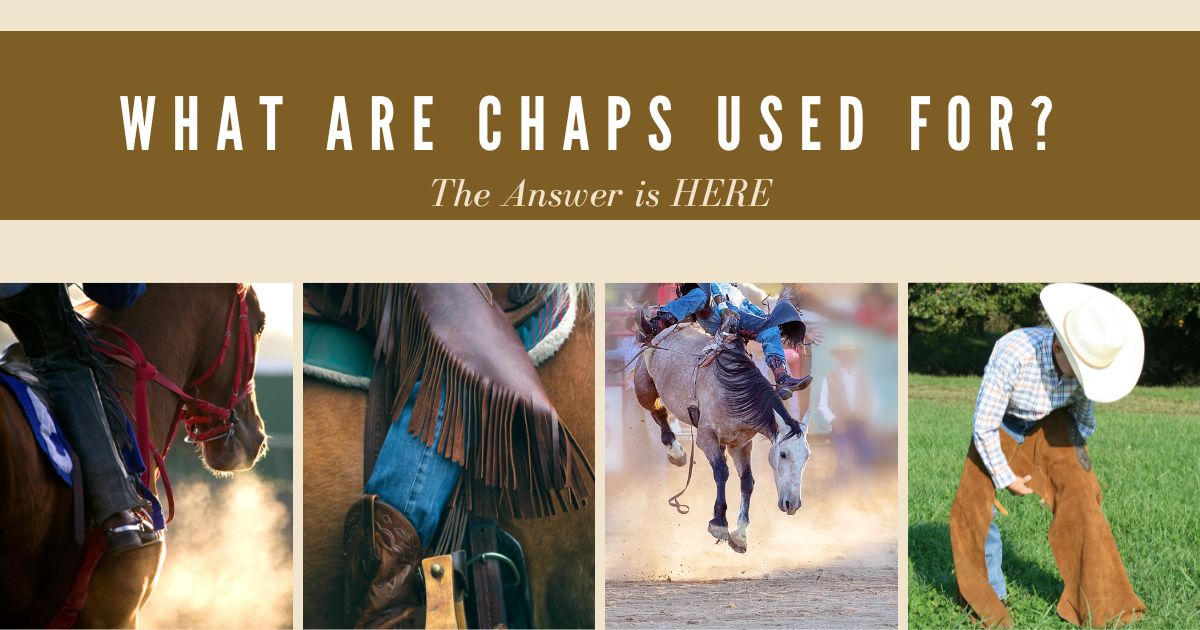What are Chaps?
Chaps are leg covers made of a sturdy material held together by a belt. However, they don’t have a covering at the bottom or crotch region. But, what are chaps used for? Except for a few vintage designs made of sheepskin, goatskin, or buffalo, equestrian chaps are mostly of cowhide leather.
There are chaps made of softer, synthetic fabrics like vinyl or Ultrasuede. You are more likely to see these at horse exhibitions than on routes.

What are Chaps Used for?
The main advantages of wearing chaps are support and protection for the legs. Chaps, however, provide several additional benefits that make them particularly beneficial for horse riders.
Practical Protection
All chaps offer some level of defense against the environment and the elements. The shotgun and batwing, for example, are fashions with thick leather more suited for use in the wild. Chaps are a good defense against the wind and cold and deflect some of the rain.
Even though severe rain will cause all leather to soak through, it is still preferable to ride with chaps on a rainy day than without.
Grip
Riding bareback or in a saddle, leather chaps offer a firmer grip than fabric breeches. They are therefore essential for bronc and bull riders.
Warmth
Chaps are excellent insulators, trapping warm air against the rider’s body, as previously noted. During the coldest winters, a decent pair of woolen chaps or woollies will keep you warm when riding a horse.
Comfort
Long rides can make one stiff and uncomfortable, especially if the horse has bony withers. Chaps are an excellent technique to prevent saddle sores and prolong your comfort while riding. Most cowboy chaps have stiff leather cushions between the rider’s knees and the horse’s back.
Riders who spend numerous lengthy hours in the saddle each day benefit significantly from this feature.
Cleanliness
Working with horses and animals takes a toll on your clothing. Chaps keep your legs safe when riding and maintain your breeches spotless and free of annoying stains.
Looks
Last but not least, cowboys and western equestrians rock the chaps look. The sole purpose of many equestrians wearing them is to simulate riding a Mustang through the Wild West like a cowboy. Some horse competitions permit chaps, and you may frequently wear them by reining and western pleasure competitors.
What are Half Chaps?
Chaps are riding apparel most commonly associated with cowboys and western riding; nevertheless, English riders also wear them. The sole of an English riding boot comes from a pair of half chaps, leaving only the upper portion of the boot.
You wear them over shorter riding boots to provide the rider additional support and protection for their legs. Sometimes, we refer to them as chapettes and cover the rider’s legs from the ankle to just below the knee. Trail riders and children who compete in horse shows are the most likely to wear this style of riding apparel.
But what are half chaps used for? Half chaps provide several uses for riders. In addition to alleviating the discomfort caused by the stirrup leather, they prevent sweat from collecting on the rider’s breeches and increase the rider’s hold in the saddle.
The Purpose of Half Chaps
What are half chaps used for? Half chaps are of leather material and have an exterior zipper or hook and loop fastener. They give the rider a firm grip and shield them from sweat and the leather of the stirrups. English-style riders frequently wear them in place of tall boots over paddock boots.
The History of Chaps
Since the original iteration of the design, chaps have undergone a great deal of evolution to become what we know and love today. In the early 1500s, when the Spaniards were transporting cattle from Cuba to Mexico, the first cowboys in the American West were looking for a way to protect their cowboy leather pants and legs while rounding up escaped livestock.
They came up with the idea of wearing chaps. The first design originates from the Spanish called an armas, a thick leather cloth that you permanently fasten to each side of the saddle pack worn by a horse. Armitas was a different type of design that emerged at about the same time.
These come from two pieces of buckskin hung from the belt. After that, they use leather straps to bind them to the ground around the legs. These armitas, which mean “small armor,” eventually gave way to the fashion of leg coverings known as “chinks” today.
As Spanish ranchers made their way north, they made several adjustments to their leg coverings to accommodate the climate and conditions they encountered. However, cowboys in Texas developed the first authentic type of chaps in the early 1800s.

Other Types of Chaps
Chaps come in various styles to accommodate varied uses and climates. The most popular types of chaps worn by horse riders are:
Half Chaps
Chaps are typically associated with cowboys and western riding, but English riders also use them. Half chaps are just an English riding boot shaft without the bottom. You wear them over short riding boots to provide the rider’s leg with additional support and protection.
Children attending horse exhibitions and trail riders seem to favor this riding apparel brand. Half chaps offer more grip in the saddle and prevent pain from the stirrup leather, preventing moisture from accumulating on the rider’s breeches.
Full Chaps
Full chaps are frequently worn in English riding, just as half chaps. Similar to cowboy chaps, they add a layer of protection throughout the entire length of the rider’s leg. Riders in various sports can benefit from full chaps in many ways.
Full chaps will keep you warm in cold weather and provide more stability on the saddle because they come from genuine leather. When you’re out and about, they will help keep your breeches clean and guard against tearing your jeans by bushes and twigs.
Shotgun Chaps
Shotgun chaps are typically used in northern states or Canada and are excellent at retaining body heat. Ironically, Texas cowboys invented them, which underwent comprehensive utilization by the late 19th century.
The first style to catch on in America was shotgun chaps. Many clinicians and professional western riders favor the shotgun design since they don’t flap around and get in the way. They are far more practical than other designs if you spend more time working from the ground.
Chinks
Because they are roughly half as long as typical chaps, we refer to chinks as “half-chaps.” Its loose-fitting design for cyclists in hotter regions is excellent since it promotes good airflow around the legs. Chinks typically have two straps on the thigh and fall a few inches below the knee.
They are baggy and are frequently light in color to keep the rider’s legs cool in the sweltering sun. Chinks have long fringes along the edges, like many other chap styles. Cowboys in the Southwestern and Pacific states and during the summertime across America frequently don this look all year long.
Rodeo Chaps/Batwing Chaps
Batwing chaps are excellent for warmer regions, just like chinks. They are a loose-fitting style of chaps with a large part that covers the boots at the bottom. This riding method facilitates mounting and dismounting a horse and allows the rider’s legs to move more freely and energetically while seated.
The design of batwing chaps, which tie around the thigh with two or three straps, is more recent in American history. On farms in Texas and other southern regions, they are especially well-liked. Rodeo chaps are a more attractive kind of batwing chaps.
Rodeo chaps feature the same cut as batwings but have more colorful ornamentation and long, flowing fringes that catch people’s attention at exhibits.
Shoeing/Farrier Chaps
When caring for a horse’s hooves, You shield a farrier’s legs from minor harm with specific chinks called shoeing chaps. They consist of thick, durable leather and are sometimes known as farrier’s aprons.
For safety, they frequently include a breakaway front. It’s interesting to note that not only farriers wear shoeing chaps during work. When performing tasks like stacking hay, ranchmen and cowboys also find them beneficial for protecting clothing from damage.
Do I Need Chaps for Horseback Riding?
What are chaps used for in horse riding? The best chaps have a snug fit on the rider’s leg and cover the calf effectively to prevent injury. Jodhpur boots offer additional ankle protection. The level of comfort during the journey is also essential. We use chaps to form the leg in the saddle properly.
This, in turn, makes it simpler to ride and assists the rider in remaining atop the horse during strenuous activities such as jumping. The most effective grip comes from chaps constructed of natural grain leather and suede.
Chaps constructed correctly stabilize the leg and prevent the skin from bruising that could be a result of the saddle or the stirrups. This is of the utmost importance in the summer and spring when temperatures are high, and riders dress in breathable and lightweight attire.
Types of Boots to Wear With Chaps
Why not just buy traditional equestrian footwear if chaps worn with jodhpur boots or sports shoes have a design that emulates the look of conventional equestrian footwear? The price is where you’ll find the solution. Long riding boots, particularly those made of genuine leather, provide the highest level of protection for your legs.
They are of superior quality; nevertheless, purchasing such boots will require a significant financial investment. Not every rider has that much, particularly not those who are just starting on their journey with a brand-new passion. The combination of Jodhpur boots and chaps is an option that can serve as an appropriate starting point.
Jodhpur boots or paddock boots with half chaps are the standard footwear for riders of horses. Half chaps are for English riding, so you cannot use them with cowboy boots. In theory, you can wear half chaps over whatever shoes or short boots you use for horse riding.
This is because the design of half chaps fits over the top of shoes. It is essential to keep in mind that your riding boots should always have heels to stop your feet from sliding into the stirrups.
FAQs on Chaps
Why Do Cowboys Wear Chaps?
If you watch western movies, you’ll notice that cowboys frequently wear chaps with long fringes when working with animals. Ranch chaps are quite useful, even though they look good on a cowboy. Cowboys wear chaps when riding to shield their legs from sharp vegetation and dense undergrowth.
Chaps also make the journey more comfortable by protecting against rope burns, animal injuries, and overall discomfort. Even the chaps’ edge fringes have a function. These little strips of leather, which resemble a horse’s feathers, aid in wicking water away from the chaps during heavy downpours.
However, not all cowboys and cowgirls who work with cattle wear chaps. They are also well-liked by the horse-mounted military, stagecoach and postal employees, rodeo competitors, and even motorcycle riders.
What are the Benefits of Wearing Chaps?
When interacting with animals, cowboys typically wear chaps that have lengthy fringes. If you’ve ever watched a western, you’ve probably noticed this. Chaps are not only stylish when worn by a cowboy, but they also serve a beneficial purpose on a ranch.
Cowboys wear chaps to protect their legs from prickly plants and dense undergrowth when riding. Chaps protect from rope burns and injuries caused by cattle, making the trip more comfortable and convenient in general. Even the fringes seen at the borders of chaps have a function.
These thin pieces of leather resemble the feathers on a horse. They use them to assist in the removal of rainwater from the chaps while it is raining.
Chaps are most commonly associated with cowboys and cowgirls who work with livestock; however, anyone can wear them. In the past, they got a liking from soldiers who rode horses, stagecoach drivers, mail employees, rodeo competitors, and even motorcycle riders.
What are Chaps Made From?
Chaps come from leather sourced from cowhide, although they can also come from wool. On the other hand, contemporary chaps frequently use materials you can clean in a washing machine, such as imitation leather or nylon.
Chaps made of leather offer numerous advantages regarding practical use, although synthetic materials are less expensive and better for the environment. They are not only hardy and weather resistant, but they also break easily if they become entangled with something.
This is the reason why chaps made of leather are safer and more practical than those made of synthetic materials. Chaps have a unique cut that allows riders to be comfortable riding in the saddle.
Chaps are without a seat and fasten using a strap around the wearer’s waist. There are several varieties of chaps, and some of them feature additional fasteners around the legs to prevent the panels from flapping in the wind.
Why Do Bull Riders Wear Chaps?
Bull riders wear chaps for the same reason as cowboys do: to protect their legs from injury if they fall from a bull. Chaps made of leather give the rider additional traction and assist them in maintaining their hold on the animal’s back.
Competitors commonly use chaps in bull riding, saddle bronc riding, and bareback bronc riding. This is not a coincidence. These are among the world’s most intense and hazardous sports; therefore, an additional defense buffer can make all the difference.

Parting Words
It is time to take a closer look at specific items now that you know what chaps are, the purpose of chaps, and how to select the appropriate pair for your needs. Keep in mind the importance of taking adequate care of your chaps.
It is important to regularly wipe the chaps’ surface with a wet or dry towel, depending on the material. Please put all your clothing, including your accessories, into a place where it won’t get wet and store it there. I pray that they continue to be of service to you for a very long time.
